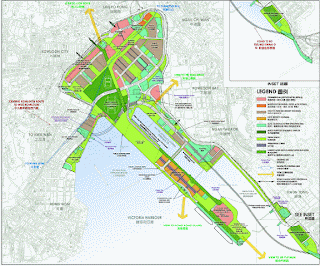Hong Kong's Former Airport Redevelopment

Known as the international airport of Hong Kong from 1925 to 1998, the Kai Tak airport was replaced by the Chek Lap Kok airport in 1998. The airport and its surrounding areas are slated for redevelopment. Located in the north side of Kowloon Bay, the project covers an area of about 328 hectares and consists of the prior airport area as well as waterfront areas of To Kwa Wan, Ma Tau Kok, Kowloon Bay, Kwun Tong and Cha Kwo Ling. After the airport closure, the site has been occupied by temporary uses such as a golf court on the previous runway, bus depots, car sales exhibitions, recreational grounds, a recycling yard, a concrete mixing plant and a flying training school. Issues with the area include the stench from the local channel, land contamination, public access and connectivity with other areas. Proposed solutions include bioremediation, cutting down on air pollution through the use of a district cooling system, and transportation improvements with light rail transit.



In 2006, a blueprint for the redevelopment of Kai Tak was created after previous efforts of reclamation were strongly opposed by the public and the Protection of the Harbour Ordinance was used by the Court of Final Appeal to establish a zero-reclamation ruling. The proposed HK$100 billion plan to be implemented from this year to 2021 has an overall vision for the area to be a harbourfront city that will be a hotspot for sports, entertainment and tourism. Proposed features include two cruise terminals, a luxury hotel, an urban park, a 200 metre high viewing tower, a pedestrian promenade along the waterfront, a district cooling system, a potential MTR station connecting Central and Sha Tin and a monorail connecting to Kowloon Bay and Kwun Tong where a revitalization project is simultaneously occurring. Surrounding developments consisting of government offices, public/private housing and commercial buildings will be low to medium density to allow for a view of the harbour and surrounding hills. Development tenders are currently being invited for the project’s infrastructure works.




Known as the international airport of Hong Kong from 1925 to 1998, the Kai Tak airport was replaced by the Chek Lap Kok airport in 1998. The airport and its surrounding areas are slated for redevelopment. Located in the north side of Kowloon Bay, the project covers an area of about 328 hectares and consists of the prior airport area as well as waterfront areas of To Kwa Wan, Ma Tau Kok, Kowloon Bay, Kwun Tong and Cha Kwo Ling. After the airport closure, the site has been occupied by temporary uses such as a golf court on the previous runway, bus depots, car sales exhibitions, recreational grounds, a recycling yard, a concrete mixing plant and a flying training school. Issues with the area include the stench from the local channel, land contamination, public access and connectivity with other areas. Proposed solutions include bioremediation, cutting down on air pollution through the use of a district cooling system, and transportation improvements with light rail transit.



In 2006, a blueprint for the redevelopment of Kai Tak was created after previous efforts of reclamation were strongly opposed by the public and the Protection of the Harbour Ordinance was used by the Court of Final Appeal to establish a zero-reclamation ruling. The proposed HK$100 billion plan to be implemented from this year to 2021 has an overall vision for the area to be a harbourfront city that will be a hotspot for sports, entertainment and tourism. Proposed features include two cruise terminals, a luxury hotel, an urban park, a 200 metre high viewing tower, a pedestrian promenade along the waterfront, a district cooling system, a potential MTR station connecting Central and Sha Tin and a monorail connecting to Kowloon Bay and Kwun Tong where a revitalization project is simultaneously occurring. Surrounding developments consisting of government offices, public/private housing and commercial buildings will be low to medium density to allow for a view of the harbour and surrounding hills. Development tenders are currently being invited for the project’s infrastructure works.




































 Local residents say that this plan to partially develop Wai Chai Market into a 46-story shopping centre and residential building and the transformation of Lee Tung Street into a Wedding City arcade of 40,000 sq.ft. and 1415 flats is only partially preserving the area’s rich cultural heritage. While the Blue House, a balconied tenement, will be preserved and residents will be able to move back in after renovations, the high-rise building being proposed for the Bauhaus style market and the commercial Wedding City do not fit into the local context. The distinctive character of diverse small shops will be gone. With the increase in rents for the new development, local businesses will not be able to afford the rent hikes and even though a short rent-exemption period will be offered, businesses may not be sustained after the exemption period since customers will be lost without a network of local businesses after the area is taken over by major property developers.
Local residents say that this plan to partially develop Wai Chai Market into a 46-story shopping centre and residential building and the transformation of Lee Tung Street into a Wedding City arcade of 40,000 sq.ft. and 1415 flats is only partially preserving the area’s rich cultural heritage. While the Blue House, a balconied tenement, will be preserved and residents will be able to move back in after renovations, the high-rise building being proposed for the Bauhaus style market and the commercial Wedding City do not fit into the local context. The distinctive character of diverse small shops will be gone. With the increase in rents for the new development, local businesses will not be able to afford the rent hikes and even though a short rent-exemption period will be offered, businesses may not be sustained after the exemption period since customers will be lost without a network of local businesses after the area is taken over by major property developers. 













